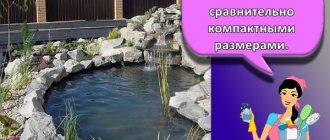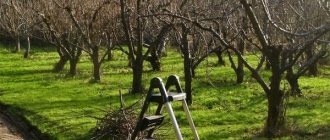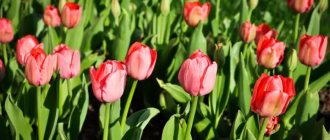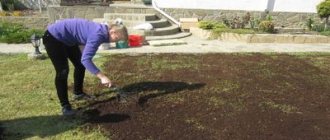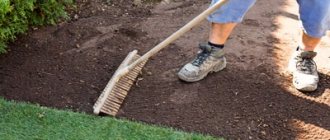A stylish, well-groomed lawn at your dacha is an excellent solution for any area, no matter how large or small it is. It can become a backdrop for flowering herbaceous plants, shrubs and trees, decorate a recreation area, playground, backyard, lawn and perform many other functions. There are many uses for these lush green lawns in landscaping, but simply preparing the area and planting it with grass is not enough. Improper lawn care will quickly negate all the efforts made and make the grass unsightly, one might even say ugly.
Reasons for the deterioration of the grass cover
Many gardeners complain that no matter how hard they try, they cannot keep their lawn looking great all the time. It would seem that at first everything goes according to plan: uniform shoots appear, the grass gives good growth and rich color, gradually thickens and gains strength, but then problems suddenly arise. Suddenly, the texture of the cover deteriorates: it becomes dry and brittle, acquires a straw color, and then thins out.
Personally, I know such problems firsthand, so let’s figure out why this happens. Why does the grass on the lawn suddenly turn yellow for no reason at all?
The main factors causing deterioration in the quality of grass stand are:
- insufficient or excessive watering;
- improper mowing;
- lack of fertilizers;
- heavy loads on the coating (intensive trampling);
- diseases;
- damage by animals.
This suggests the conclusion that often a green carpet loses its attractiveness as a result of the owner’s mistakes.
Pest, disease and weed control
Weeds sometimes appear on lawns and must be promptly removed. If it is a single bush that sticks out forlornly in the middle of a flat surface, then it can be carefully uprooted by hand. When the lawn is completely covered with ubiquitous weeds, you should go to a special store for targeted herbicides. Such compositions remove broad-leaved plants, but cause virtually no harm to lawn grass.
A lawn, as a large living organism, can suffer from various diseases, usually fungal diseases. Defeating such a scourge is not so easy. Sometimes it is necessary to remove entire pieces of contaminated coating.
Another threat to lawn grass is pests. For them, moist soil with young shoots and succulent roots becomes a real paradise. Insects lay larvae under the grass layer, which quickly develop and begin to undermine the plants from below. Pests, diseases, weeds - all these problems can be solved in one fell swoop if you use preventive measures and treat the lawn at the beginning of the season with special preventive compounds.
If you don’t have a lawn yet or have an old one with bald spots that needs replacing, contact our company! From us you can order a healthy rolled lawn in the Rostov region at a competitive price. By calling the number on the website, our specialists will answer your questions and help you make an application.
Basic care for lawn grass throughout the year
After completing the tedious work of laying a lawn, you just want to breathe a sigh of relief and finally relax. Moreover, the lawn had already turned green and began to captivate with its beauty. But do not forget that the vegetation requires constant attention throughout the summer season.
Spring
The first work should begin with the beginning of the thaw. At this time, frequent temperature changes occur, as a result of which the snow becomes dense and retains moisture, and an ice crust forms on the surface, preventing the flow of air to the turf. To prevent grass rotting and damage to the root system, it is necessary to carefully break the ice and remove excess snow from the areas where the lawn is located.
After the final melting of the snow cover, when the ground dries out a little, use a fan rake to clear the surface of debris, dry grass and leaves. There is no way to leave such debris on the lawn, because as it accumulates and cakes, it turns into a kind of felt covering the lawn. This leads to fungal infections and the appearance of parasites, interferes with the germination of young grass and reduces the density of the cover.
In May, as soon as the grass stand grows to a height of about 10 cm, make the first cut, removing the very tips (1 - 2 cm). Apply fertilizing with a nitrogen mixture or starter fertilizers (TerraSol “Spring-Summer”, Lawn City, Fertika) to restore the root system and stimulate growth. At the same time, water abundantly to avoid plant burns.
If there are signs of fungus, treat with fungicides: Benomyl, Propiconazole, Fertilome Systemic, Triadimefon, and sow grass mixture into bald spots. If necessary, mulch. After the second or third cut, aerate.
All spring work should be done very carefully, since after winter the turf is waterlogged and is especially susceptible to damage.
Summer
At the beginning of June, it is time for active weed control. It is better to remove them manually so as not to damage the turf. If a herbicide is used, fertilizing should be applied a few days before treating the area, and after the weeds die, spray with Megafol or Epin to remove the grains from the state of stress.
In the summer months, the grass needs to be fully watered 2-3 times a week and regularly mowed as the cover grows 8-10 cm from the ground.
It is important to remember about fertilizers, which are an integral part of lawn care throughout the entire period of operation. Without them, the grass stand will be weakened and will not be able to resist diseases. Complex mixtures are more suitable for summer: Actiwin “Summer-Autumn”, Florovit, Agrecol. They should be applied approximately once a month, depending on the condition of the coating.
In August, you need to remove the weeds again, fertilize the area with autumn compositions Fertika “Lawn-Autumn”, Bona Forte, Actiwin and restore the damaged areas. Also, do not forget to comb out the grass and perform scarification (loosening the soil).
Autumn
During this period, the lawn must be properly prepared for winter, so that in the new season it will appear before you in all its splendor and cause less trouble.
At the beginning of September, aerate again and apply potassium and phosphorus fertilizers to strengthen the root system before the onset of cold weather. Haircuts now need to be carried out no more than once every two weeks, and the last one at the end of October.
The lawn should be watered in the fall only in dry weather, only once a week, and the final watering should be done in early October. Avoid overwatering, as in damp soil the root system of plants weakens and may even die with the arrival of frost.
Now remove fallen leaves, debris and any excess to prevent the grass from damping off and rotting over the winter. Spread mulch to protect the soil from washing away. The final stage is sowing seeds in bare areas. After this, walking on the grass is not recommended.
Winter
At this time of year, virtually no action will be required from you. It is only necessary to exclude any load on the coating, since in winter it is the most fragile.
Until a snow cover of 30 cm thick has formed on the lawn, it is better not to walk on it.
There is no need to remove snow from the site. But the ice crust that forms after a thaw must be carefully broken with some tool, for example, a rake.
A little about herbicides
The war against weeds is considered a long and exhausting task. As you can see in the photo of lawn care, the main tool is a narrow scoop or knife. They dig up perennial weeds, trying to cut off their roots deeper.
However, it is difficult to mechanically remove dandelions, etc., especially if the lawn is neglected. Therefore, gardeners increasingly prefer to use herbicides - the use of such preparations reduces labor costs by 80 - 90%.
Herbicides can have a continuous effect (Amitrol-T, Roundup) and a selective effect. The latter type of drugs give the best results. They contribute to the destruction of dicotyledonous plants and do not harm monocotyledonous plants, i.e., cereal crops.
In any case, working with herbicides requires strict adherence to safety precautions. All such substances are highly toxic. Therefore, spraying with them must be carried out armed with goggles, a respirator, rubber gloves and boots.
You should also not forget about the negative consequences for the environment - some drugs can remain in the soil for a long time.
Watering the lawn
It's no secret that water is vital for any plant. Without regular irrigation, the emerald lawn will quickly turn into a shabby wasteland with the remains of withered grass, which is unlikely to be restored. Watering not only protects the coating from drying out, but also promotes the flow of nutrients into the root system, thereby strengthening it.
In summer, the lawn should be moistened every 2 - 3 days, preferably in the morning, wetting the soil to a depth of about 20 cm. In extreme heat, the procedure is performed daily, and on rainy days it is minimized or canceled altogether, remembering that dampness is no less harmful to the surface, than sushi.
Water for irrigation should not be too cold so as not to cause stress in plants, as a result of which they stop absorbing moisture and beneficial microelements from the soil. It is best if its temperature is as close as possible to the air temperature.
You can irrigate the turf only by spraying (sprinkling), and in no case with a continuous stream from a hose. The most effective way to do this is with automatic irrigation systems that can evenly cover a large area. It is advisable to install automatic watering at the initial stage of site development, before planting the lawn. Otherwise, when performing work on laying the system on an already formed coating, you risk hopelessly ruining it.
Preparing your lawn for winter
To avoid having to work hard to restore the lawn in the spring, it is advisable to cut the grass in the fall. This is important, since growth continues until the air temperature drops to +5 degrees. It is advisable to make a haircut two weeks before the first frost.
In autumn, it is better to limit movement on the lawn, especially if the area is characterized by frequent rains. To improve the ventilation of the lawn, you need to aerate it and apply fertilizer one last time before winter. The fertilizer should contain only phosphorus and potassium. This will reduce the growth of greenery and direct nutrients to the development of the root system. Until early to mid-October, you need to continue regular watering according to summer rules, and then stop it completely.
Haircut, piercing and combing, watering, feeding should be regular. This will help maintain a beautiful green and uniform appearance of the lawn and easily withstand frost. And it won’t take much effort to restore your lawn in the spring.
dizlandshafta
Cutting the grass
Another mandatory step in caring for a plant carpet is mowing. It performs the following tasks:
- prevents the chaotic growth of cereals throughout the area;
- helps in the fight against weeds, as they do not tolerate such a procedure;
- leads to leveling of the cover;
- stimulates grass growth, resulting in the turf becoming dense and dense;
- Thanks to mowing, the lawn takes on an elegant, well-groomed appearance.
Mowing is carried out only when the turf is dry, in cool weather, leaving stems at least 5 cm high on the surface. The frequency depends on the growth rate of the grass, usually once every 2 to 4 weeks. To carry out the work, you will need to choose a high-quality lawn mower or trimmer.
Before you start cutting, remove all foreign objects from the site so as not to damage the tool and allow the blades of grass to straighten. You should mow in two directions - first along the site, and then across.
To the question: is it necessary to remove mowed grass from the lawn, the answer is unequivocal - yes it is necessary. Otherwise, soil ventilation is disrupted, the plants begin to hurt, and their structure and appearance noticeably deteriorate. But where do you put the grass after mowing the lawn, you ask? There can be many options:
- use for preparing compost and other fertilizers;
- dry and, setting fire in some container, repel mosquitoes with smoke;
- use as mulch;
- place in holes with cucumbers, tomatoes, peppers and zucchini to retain moisture and support the vines.
In this way, you will tidy up your lawn and get a valuable, versatile material containing rich nutrients drawn from the soil.
Calculation of doses of mineral supplements
It is generally accepted that 1 sq. a meter of lawn requires 24 g of nitrogen, 36 g of phosphorus and 24 g of potassium. Gardeners are advised to give preference to domestic fertilizers, for example, ammonium and potassium nitrate.
Let's start the calculation. As is known, the nitrogen content in ammonium nitrate is 34.5%, double superphosphate contains 50% phosphorus, and potassium chloride contains 60% potassium. Based on this, it is necessary to add approximately 70 g of ammonium nitrate and superphosphate, as well as 60 g of potassium salt, to the soil per season.
Mulching turf
To protect plants from weeds, drying out or waterlogging, sudden temperature fluctuations and other unfavorable external factors, gardeners use such a popular agricultural technique as mulching.
It consists of applying a special layer of any organic material (peat, hay, sawdust, compost, agrofibre, etc.) to the surface of the earth with growing crops. This method gives the following effect:
- retains soil moisture, so you can reduce the frequency of watering;
- protects the root system from harmful weather conditions: heat, frost, winds;
- prevents plant rotting;
- regulates soil acidity;
- prevents the spread of weeds;
- retains nutrients in the soil and additionally fertilizes it during the process of decay;
- smoothes the surface.
Mulching is carried out only on dry soil, without compacting. First, the soil must be loosened and cleared of weeds. The material is laid out in an even layer 5–10 cm thick. For the lawn, mulching is used in two cases: immediately after planting the seeds and in the fall as a measure to prepare the coating for the winter period.
Basic aspects of care
In total, there are five different mandatory procedures necessary to maintain a well-groomed and attractive appearance of lawn grass. If you follow the rules, then your site will delight the eyes of others for a long time. Moreover, in many landscape design projects, the lawn is the main object.
How to water
Every plant requires water and lawn grass is no exception, which means it also needs to be watered regularly and abundantly. When watering, it is important that moisture penetrates at least 20 centimeters deep into the soil. This must be done every day a couple of times in the morning.
If you do this only in the evening, you can provoke the appearance of fungus in cold weather. During periods of drought, you will have to water three times a day, but during rains you don’t have to do this at all.
You should not water with cold water, because this will simply deprive the grass of nutrients (as it will experience stress). And for watering it is recommended to use a hose with a special diffuser. Remember that too much water can seriously damage the plants.
How to cut hair
The lawn needs to be mowed approximately once every couple of weeks, but sometimes it can be done once a month, which directly depends on the type.
For example, if it is clover, then you can mow it not often, but cereals, on the contrary.
This procedure is necessary to level the grass, and is also used to eliminate weeds and stimulate plant growth.
Mow the area first crosswise and then lengthwise and make sure that after the lawn mower the grass is no less than five centimeters. Be sure to remove any plants left after cutting.
Aeration
Cereals are distinguished by rather powerful roots, which, when growing, compact the soil well, and this seriously impedes the passage of nutrients with oxygen.
To avoid problems and keep your lawn healthy, you need to aerate the soil twice a year. Let's imagine that you have a rolled lawn, then it is enough to use a mechanical aerator or an ordinary fork and pierce the ground to a depth of no more than 15 cm.
When you are done with aeration, it is recommended to fertilize the soil well.
Mulching
This procedure is the most recommended, because mulching acts as a protective function against waterlogging, sudden temperature changes, aridity, etc. Just sprinkle organic matter on top, such as hay, sawdust or peat.
It is important to mulch the planting sites immediately after sowing the lawn, as well as in the autumn before the onset of frost.
Scarification
Scarification is another effective way to aerate the soil. Some will think that this is the same solution as aeration. In fact, there is a huge difference between them.
If you carry out scarification correctly, you will significantly speed up the growth of the grass, as well as increase their density and help them take root. Moreover, you will even notice an improvement in the color, which will become even richer.
For scarification, you will need a special scarifier knife, with its help you need to process the area lengthwise and crosswise. Sometimes fan rakes are used to loosen the soil. When you finish this procedure, do not forget to mulch the soil.
Soil aeration
The powerful roots of cereal grasses, quickly growing on the lawn, compact the soil, thereby creating a barrier to the penetration of oxygen and nutrients into the inner layers. Without sufficient air flow, plants become lethargic and weak, unable to withstand the effects of the environment. To help them and prevent them from dying, an event such as aeration or airing of the soil is carried out.
This procedure is loosening, i.e. piercing the soil with special devices to a depth of 10 - 15 cm. It must be performed at least twice a year - in spring and autumn, first clearing the lawn of dry grass. Tools can be used: regular or tubular forks, aerator sandals, mechanical or motorized aerators. Upon completion of the procedure, it is advisable to add fertilizer to the soil.
Mowing
The first mowing of the lawn is carried out as soon as the height of the grass has reached 15 cm. A lawn mower is used for this purpose. Mowing is carried out at a level of 4 - 5 cm. It is recommended to carry out the procedure a second time when the grass reaches 7 - 10 cm. Extreme manipulation is done in early autumn.
Soil scarification
Another method of loosening the soil is scarification. Its technology is significantly different from aeration, although it pursues the same goals. The difference is that with this method there is a deeper impact on the soil, cutting it lengthwise and crosswise. Usually scarifiers are used for this (equipment with sharp metal knives), but in small areas it is quite possible to get by with fan rakes, working with them in different directions.
Scarification has the following effects on the lawn:
- improves the supply of moisture and sunlight to the roots;
- accelerates grass growth, making the cover thicker;
- gives the lawn a healthy, rich color;
- promotes the rooting of cereals;
- prevents plant rotting and the spread of infections.
After loosening, it’s a good idea to sand the surface and spread mulch from cut grass.
Weeds on the lawn
Gardeners understand weeds as plants that are not part of the original grass mixture. Weeds can be annuals, perennials, tree seedlings and even cereal crops. They can get onto the lawn from the soil or from the lawn seed mixture. They can also be brought by meltwater streams and wind.
Weeds disrupt the appearance of the lawn - it ceases to be uniform. In addition, they compete with cereals in consuming soil resources. The number of weedy perennials and their hostility increases if the growing conditions of the seeded grass worsen, but even competent care does not guarantee their absence from the grass stand. Therefore, both a young green carpet and an adult should be weeded.
Weed control is a difficult task. That being said, you must understand that fighting buttercups or knotweed in a mature, quality lawn is about eliminating the results of faulty maintenance or excessive restoration work.
Due to all of the above, the best way to avoid the dominance of weeds on your favorite grass area is the systematic implementation of all necessary agrotechnical measures.

